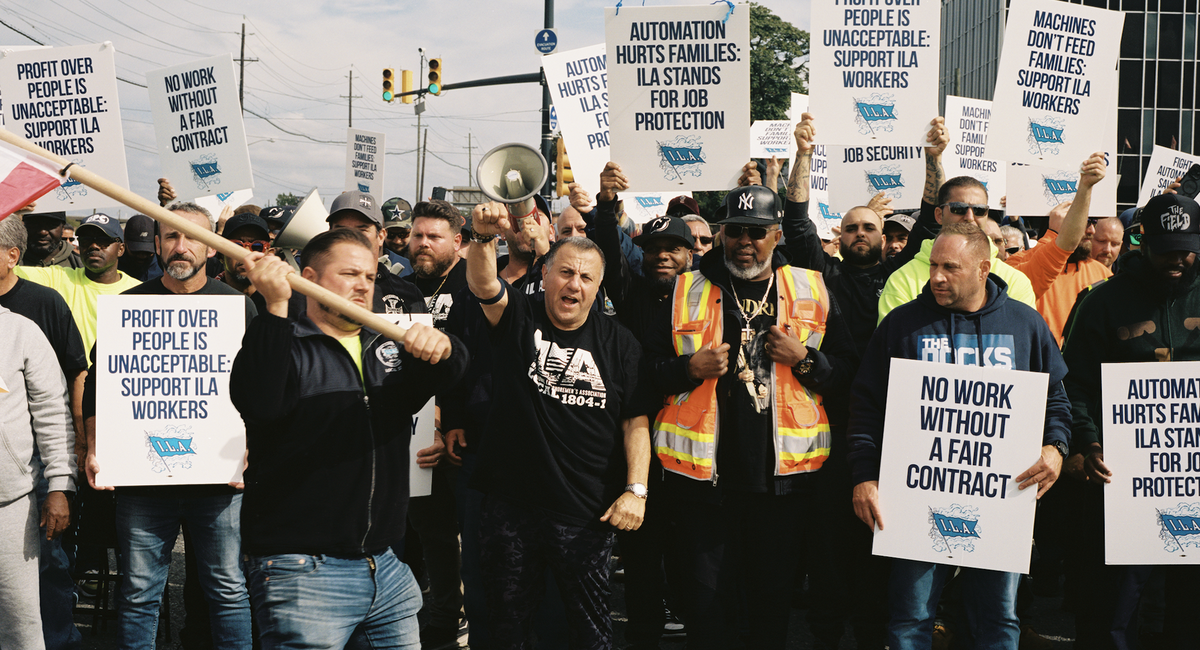As a dockworker strike froze freight traffic at seaports along the East Coast on Tuesday, International Longshoremen’s Association President Harold Daggett arrived at the Port of Newark to rally his union’s members to push ahead with a labor action that could put a sizable dent in supply chains across the New York metropolitan area.
Daggett swaggered out of a 2024 Land Rover into a cheering crowd of cigar-chomping stevedores at the port terminal’s entrance and shook hands with Port Authority police officers stationed along the picket line.
“Those companies overseas, those miserable bastards that make so much money off our backs, we’re going to make sure they’re going to pay for it,” Daggett bellowed to the crowd before taking off to rally picketers at another pier. The union is demanding higher pay and protections from the automation of its members’ jobs.
But international freight shippers aren’t the only ones who risk taking a hit from the strike. Consumers in New York and New Jersey who rely on the millions of tons of goods and materials that arrive at the seaports every year also risk feeling some pain, according to experts.
Everything from food to construction materials to the Land Rover Daggett arrived in enters the region through New York Harbor’s seaports. The strike shutting them down presents the biggest disruption to supply chains since the COVID-19 pandemic. Experts said that if the strike drags on for days or weeks, its effects could trickle down to everyday people.
The longer the strike persists, the harder its effects on everyday people
Darin Miller, National Director for Marine at the insurance company Sedgwick, warned that costs could be passed onto consumers if the strike doesn’t end soon.
“If we’re going into weeks, that’s where you’re really gonna start feeling an impact on the shelves,” said Miller. “It’s costing billions per day that this goes on. It’s going to affect the economy overall.”
Many of the cars New Yorkers drive come off the docks
The seaports in New York and New Jersey handled the import of more than 360,000 cars last year, according to the Port Authority. The agency advertises the port as one of the top auto processing gateways in the United States with “direct access to one of the most affluent consumer markets in the world.”
Those include cars from high-end manufacturers like Ferrari, Rolls-Royce, Maserati and Lexus.
For every day the strike goes on, roughly 1,000 cars aren’t able to come off the New York and New Jersey seaports to be sold.
The strike could also imperil construction in New York City
The strike is also imperiling raw building materials that are essential to construction in the region. The seaports handled more than 200,000 cubic yards of cement and cobblestone in 2023, according to the Port Authority.
Building developers in the United States use tons of glass produced overseas, and much of it arrives here by ship, said Ralph Esposito, national president of the Boston-based construction company Suffolk.
He said materials that come through the ports are necessary for “the facades of the buildings that we create” and “for cabinetry, for stone, for transformers, for switchgears that help us electrify buildings.”
“Depending where you are in the process, when those materials don’t show up, you know, at some point the project comes to a grinding halt,” Esposito said.
Tons of MTA equipment arrives in New York through the seaports
The MTA orders heaps of parts to maintain New York City’s subway system from Malaysian and Sri Lankan suppliers, and they all arrive through the ports. Workers at the ports of New York and New Jersey — who are now on strike — have unloaded more than 17 tons of parts for the MTA since June, according to shipping data collected by ImportYeti.
Those parts include equipment used to maintain subway cars. Future shipments of those pieces could languish at sea until the strike ends.
MTA officials said the agency has enough inventory on hand to keep its operations moving for the next few months, but warned that supply could eventually run out. “We will monitor the impact of the strike on the supply chain, much as we did during the pandemic,” said MTA spokesperson Aaron Donovan.
Mountains of fruit and booze also stuck offshore
Dock workers moved thousands of containers of liquor and other beverages through New York and New Jersey’s seaports last year. Everything from affordable wine to fine champagnes and burgundy wine is unloaded from ships before it arrives at store and restaurants across the region.
Many of those goods are already on the way but will remain stuck in containers until the strike ends, said Tommy Coperine, who works on the supply chain for spirit importer Frederick Wildman.
“The East Coast is our bread and butter for the vast majority of the products we’re bringing in,” he said.
Vegetables, fruits and nuts are also big movers, with port workers moving more than 100,000 containers of these goods through the ports in 2023. That means that every day the strike persists, heaps of lemons, oranges, clementines and more could be spoiling miles offshore.
